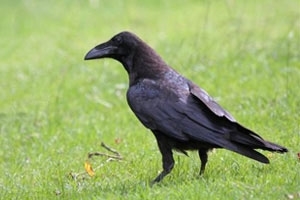Raven (Corvus corax)
 The raven is one of the first birds to get the breeding season under way, building its large nest made of twigs and lined with moss and sheep’s wool in January and laying eggs in February. In the traditional upland strongholds of Scotland, the Lake District and Wales the nest is usually placed on an inaccessible rock face. However, in the last few years, ravens have spread steadily eastwards across England using large trees and electricity pylons as nest sites. This recent easterly spread is probably due to the enlightened views of the modern gamekeeper, who now tolerates this big black member of the crow family – it is also now a protected species.
The raven is one of the first birds to get the breeding season under way, building its large nest made of twigs and lined with moss and sheep’s wool in January and laying eggs in February. In the traditional upland strongholds of Scotland, the Lake District and Wales the nest is usually placed on an inaccessible rock face. However, in the last few years, ravens have spread steadily eastwards across England using large trees and electricity pylons as nest sites. This recent easterly spread is probably due to the enlightened views of the modern gamekeeper, who now tolerates this big black member of the crow family – it is also now a protected species.
It might appear to be a strange time of year to start a family, but in the past the countryside would have been scattered with carcases of stock that had succumbed to the rigours of winter, providing the carrion-eating raven with a plentiful food supply. By the time the young hatch out, lambing will be under way with its accompanying afterbirth – a great favourite of ravens and their chicks! Occasionally ravens will pick on a sickly or newly born lamb, which understandably makes them unpopular with farmers.
As well as being disliked by sheep farmers, ravens carry a lot of mythical baggage. It has a harsh call and frequents lonely, bleak places and is often found in association with death, resulting in it being labelled as a bird of ill-omen and leading to the collective noun an “unkindness” of ravens. The best known ravens in this country are, of course, those at the Tower of London, and legend has it that King Charles II ordered their destruction only to reverse his decision when told that if the ravens left the Tower, not only would the tower collapse and the monarchy be terminated, but also a great disaster would befall the whole kingdom.
It was therefore agreed that at least six ravens should be kept at all times in the Tower and a dedicated “Raven Master” picked from one of the Beefeaters, would care for their wellbeing, which of course is still the case today. Some of these “pampered” ravens can live to a ripe old age, with the oldest one, who went by the name of Jim Crow, living for 44 years.
Peter Thompson
Advisory

Download Peter Thompson's essential 26-page book, featuring beautiful photography and detailed profiles of Britain's wildlife
Download FREE >